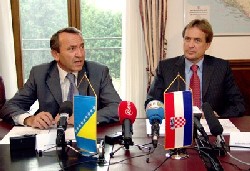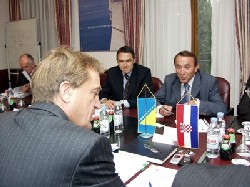


Construction activities, in the Corridor 5C through Croatia in the area of Andrijevci – Čajkovci – Perkovci along the Corridor line from Sredanci to Osijek, will start on Thursday, 22 September 2005. This announcement was made by the Minister for the Sea, Tourism, Transport and Development, Božidar Kalmeta, after the meeting held with the Minister for Transport and Communication of Bosnia and Herzegovina, Branko Dokić.
Minister Kalmeta informed Minister Dokić, that almost all preparations for the beginning of the construction of the bridge mainland – Pelješac, were completed. The construction was planned to start in October after the receiving of the necessary permit. Minister Kalmeta stated that this was an issue of territorial waters which were under the sovereignty of the Republic of Croatia. But according to the maritime law – Croatia had the duty to provide a secure passage for the neighboring country.
That is why the Croatian side had presented fragments from the study on secure passage - the dimension of the bridge was appointed based on that study. It was Croatia"s suggestion that the span between the columns in the middle of the bridge should be 170 meters, and its height 35 meters. Considering the depth of the Bay of Mali Ston, the navigation and the development of the mare culture in the area of Neum – Klek, Kalmeta concluded that these dimensions were more than enough for the passage of larger ships. Croatia would send this study to Bosnia and Herzegovina as soon as possible, hoping to receive a fast answer.
 Minister Dokić said that his side would appoint a group of experts who would analyze the study, so that this question could be solved to the satisfaction of both parties.
Minister Dokić said that his side would appoint a group of experts who would analyze the study, so that this question could be solved to the satisfaction of both parties.
Minister Kalmeta added that it had been agreed upon to organize a Mixed Committee for the coordination of the transport connections between the two countries. This document had already been accepted by the Council of Ministers of Bosnia and Herzegovina while Croatia would discuss this matter on one of the following Government sessions.
Additional issues were discussed: the establishing of other meeting points along motorways between the two countries, for example along the routes of the motorway Banja Luka – Okučani and Tuzla – Orašje – Županja, followed by those in the Corridor 5C, in the north (Odžak) and in the south (Grabovine) which have already been coordinated.
Kalmeta added that, regarding the Adriatic – Ionian traffic route, the representatives of both countries were aware that for a number of other countries this traffic route represented a strategic European corridor. Still, there were neighboring countries not agreeing with such a point of view. Finally Kalmeta concluded that it was the common belief of both countries that this route had to be a Pan European corridor and that both countries would continue to work towards that goal.
 Minister Dokić said that Bosnia and Herzegovina was working on a study - project documentation for the Corridor 5C, with the help of the Civil Engineering Institute of Croatia. The studies would be completed at the end of October, and then they would start looking for a financing model for the construction of the Corridor 5C. He announced an international conference which would be held in Sarajevo on November 17th, where the report on the documentation for the traffic route would be presented and where the international financial institutions and big companies would be invited to become potential concessionaires based on the model BOT (Build, Operate & Transfer).
Minister Dokić said that Bosnia and Herzegovina was working on a study - project documentation for the Corridor 5C, with the help of the Civil Engineering Institute of Croatia. The studies would be completed at the end of October, and then they would start looking for a financing model for the construction of the Corridor 5C. He announced an international conference which would be held in Sarajevo on November 17th, where the report on the documentation for the traffic route would be presented and where the international financial institutions and big companies would be invited to become potential concessionaires based on the model BOT (Build, Operate & Transfer).
In the end Dokić announced the initiative to organize a meeting for four ministers of the countries who have signed the general contract regarding the Sava River. The meeting of the Ministers of Croatia, Bosnia and Herzegovina, Slovenia, and Serbia and Montenegro should be organized at Brčko during the second half of November. After this meeting an initiative should head towards the Stability Pact – regarding the financing of the organizing of the Sava River and of securing navigability.
According to the estimation of the Sava Committee, to reinstate navigability of the Sava River, another EUR 15 million would be necessary. Dokić also concluded that an agreement was reached regarding the fact that a lot was to be expected from the Stability Pact related to this project.
He also said that since this was a typical example of one matter important to more countries, it was their wish that the document should be signed at Brčko. At the same time, all countries involved should choose a more firm approach towards the Stability Pact and other financial institutions of Europe.